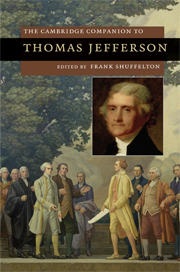Book contents
- Frontmatter
- Introduction
- 1 The Declaration of Independence and the new nation
- 2 Jefferson’s conception of republican government
- 3 Notes on the State of Virginia and the Jeffersonian West
- 4 Jefferson and Native Americans: policy and archive
- 5 Race and slavery in the era of Jefferson
- 6 Jefferson’s people: slavery at Monticello
- 7 Jefferson, science, and the Enlightenment
- 8 Thomas Jefferson and the creation of the American architectural image
- 9 The politics of pedagogy: Thomas Jefferson and the education of a democratic citizenry
- 10 Jefferson and religion: private belief, public policy
- 11 Jefferson and the language of friendship
- 12 Jefferson and Adams: friendship and the power of the letter
- 13 The resonance of minds: Thomas Jefferson and James Madison in the republic of letters
- 14 Jefferson and the democratic future
- Further reading
- Index
3 - Notes on the State of Virginia and the Jeffersonian West
Published online by Cambridge University Press: 28 May 2009
- Frontmatter
- Introduction
- 1 The Declaration of Independence and the new nation
- 2 Jefferson’s conception of republican government
- 3 Notes on the State of Virginia and the Jeffersonian West
- 4 Jefferson and Native Americans: policy and archive
- 5 Race and slavery in the era of Jefferson
- 6 Jefferson’s people: slavery at Monticello
- 7 Jefferson, science, and the Enlightenment
- 8 Thomas Jefferson and the creation of the American architectural image
- 9 The politics of pedagogy: Thomas Jefferson and the education of a democratic citizenry
- 10 Jefferson and religion: private belief, public policy
- 11 Jefferson and the language of friendship
- 12 Jefferson and Adams: friendship and the power of the letter
- 13 The resonance of minds: Thomas Jefferson and James Madison in the republic of letters
- 14 Jefferson and the democratic future
- Further reading
- Index
Summary
In spring 1784, first-term Congressional delegate Thomas Jefferson chaired the committee that drafted a plan for western government. At stake was the dimly defined territory past the Appalachians, ceded in the 1783 Peace of Paris that ended the war with England, and contested between several former colonies. The “Report of a Plan of Government for the Western Territory” defined boundaries; set liberal terms for “free males of full age” to meet and establish a “temporary government”; banned slavery after 1800; zoned and named future states; and established a timetable for entering the union on “equal footing” with the existing thirteen. Congress made some revisions and adopted the committee's plan as the Ordinance of 1784 that April. The most significant changes were dropping the “hard names”: Cherronesus in what is now Michigan, Assenisipia for today's northern Illinois and southern Wisconsin, and Pelisipia in eastern Kentucky. Over the next three years Congress passed a series of measures designed to bring revenue-bearing settlement and stability to a region that policy makers regarded as both dangerously fractious and rife with potential. A Land Ordinance of 1785 charged the geographer Thomas Hutchins with marking thirteen “ranges” (or columns) of property along the Ohio River. Angry squatters, Native Americans, and the “mirey swamps,” however, allowed Hutchins to complete only seven of the thirteen and the survey failed to generate the much needed revenue. In 1787 Congress passed the Northwest Ordinance, which tightened the channels of speculation and government control in the Ohio Valley.
- Type
- Chapter
- Information
- The Cambridge Companion to Thomas Jefferson , pp. 47 - 60Publisher: Cambridge University PressPrint publication year: 2009
- 1
- Cited by

